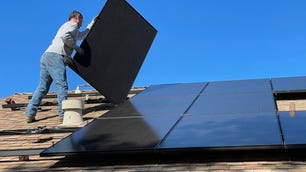These States Are Poised for Community Solar Growth, Report Finds
Community solar can help those with no access to solar panels switch to clean energy. Here's why these programs might see growth in the near future.

Community solar programs expanded in key states in 2023 and a new report by a leading company in the industry points to significant growth in the next few years.
Instead of buying and installing solar panels on your home -- a decision that could see you footing steep upfront costs -- community solar programs allow residents to subscribe to pull their energy from large arrays of solar panels located nearby.
Current community solar programs generate enough electricity to power 918,000 homes, according to the report by Arcadia, a major community solar company, but Arcadia's analysis expects that figure to grow to 4.5 million homes by 2027. That tracks with the goal of the Coalition for Community Solar Access, a trade organization, of 30 gigawatts of community solar projects across America by 2030.
Can solar panels save you money?
Interested in understanding the impact solar can have on your home? Enter some basic information below, and we’ll instantly provide a free estimate of your energy savings.
On Tuesday, Principal Deputy Assistant Secretary Jeff Marootian of the Department of Energy challenged the community solar industry to triple its energy output by 2025 during his address at the National Community Solar Partnership Annual Summit.
"There are at least 2.2 gigawatts of low-income community solar projects already in the pipeline," Marootian said. "Along with over 80 projects in our community power accelerator." Marootian pledged to help the community solar industry accomplish this goal, citing the necessity of making solar energy accessible and affordable for every US citizen.
Arcadia attributes the growth of community solar to increasingly positive public sentiments about solar farms -- roughly 75% of Americans wouldn't mind living near one, according to a Washington Post-University of Maryland poll conducted last year -- and increased funding for community solar projects from the Inflation Reduction Act. More specifically, the IRA funded the largest community solar module purchase in US history, which the report says could contribute to the development of 400 community solar projects nationwide.
Community solar programs still face some hurdles in the near future. Arcadia warns that high interest rates, increased local opposition and unfriendly regulatory environments might impede community solar development in certain areas. Workforce issues and whiplash from a Trump-era tariff on Chinese-made solar panels may also slow projected growth.
Here are the states where customers should be keeping an eye out for growing community solar programs. Community solar growth in your area could make the switch to clean energy more accessible to you, allowing you to save up to 10% on your electric bills annually.
What states have expanding community solar programs?
The biggest community solar expansions in 2023 happened in New Jersey, Minnesota, Oregon and New Mexico.
New Jersey's Board of Public Utilities established a permanent community solar program in the state. Minnesota lawmakers carved out 30% of community solar capacity for low- and middle-income residents, as well as groups such as nonprofits and libraries.
Oregon community solar programs expanded in 2023, with a new partner company beginning to sign subscribers during the year. Finally, a third-party administrator in New Mexico selected 45 community solar projects to begin coming online in 2024.
The biggest states to keep an eye on for potential community solar project expansion are Wisconsin, Michigan and Pennsylvania, according to Arcadia's report.
Wisconsin lawmakers have attempted to legislate a community solar program into existence three times in the past, and 2024 will herald their fourth attempt. Proposed legislation in Michigan would also create a community solar program in 2024, enabling projects up to 5 MW in size and passing savings on to subscribers in the form of an energy bill credit.
Finally, while Pennsylvanians living in shared residences, apartment buildings or under shaded roofs are currently prohibited from installing their own solar panels, a new bill would let them subscribe to community solar.
Community solar for you
Arcadia reports that nearly two thirds of Americans lack access to rooftop solar, whether because of state law, high costs or because they rent a home or live in an apartment.
In states where community solar programs exist, they might serve as the solution for low- and moderate-income households who can't take advantage of rooftop solar. Renters and homeowners living in shaded areas are also more likely to benefit from local community solar programs.
Community solar programs are appearing in new states, but not every community solar program has reached maturation yet.
Subscription to community solar will make your utility bill look different. You might get two separate smaller bills, or you might get a bill where the electricity generated by the solar array is credited against your utility usage. Either way, the Department of Energy estimates that typical electric bill savings are 10% annually for community solar subscribers.
Make sure to do your research on your state's community solar programs before deciding to subscribe.
Solar Installer Guides
Best Solar Products and Companies
Solar Installers by State
Solar Installers & Storage
Solar Resources and Guides
Other Energy Saving Guides
Other Types of Energy
Living Off the Grid Series


